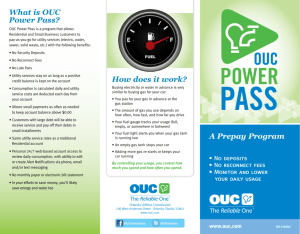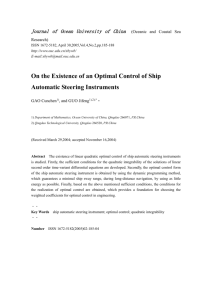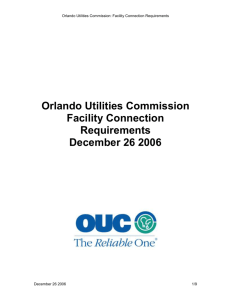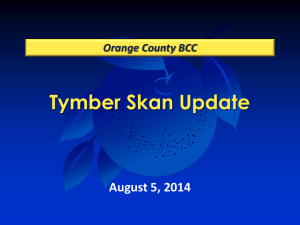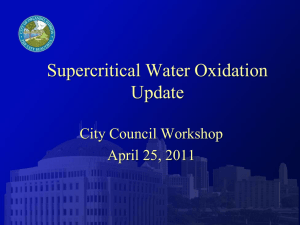Storm Preparedness Report - Public Service Commission
advertisement
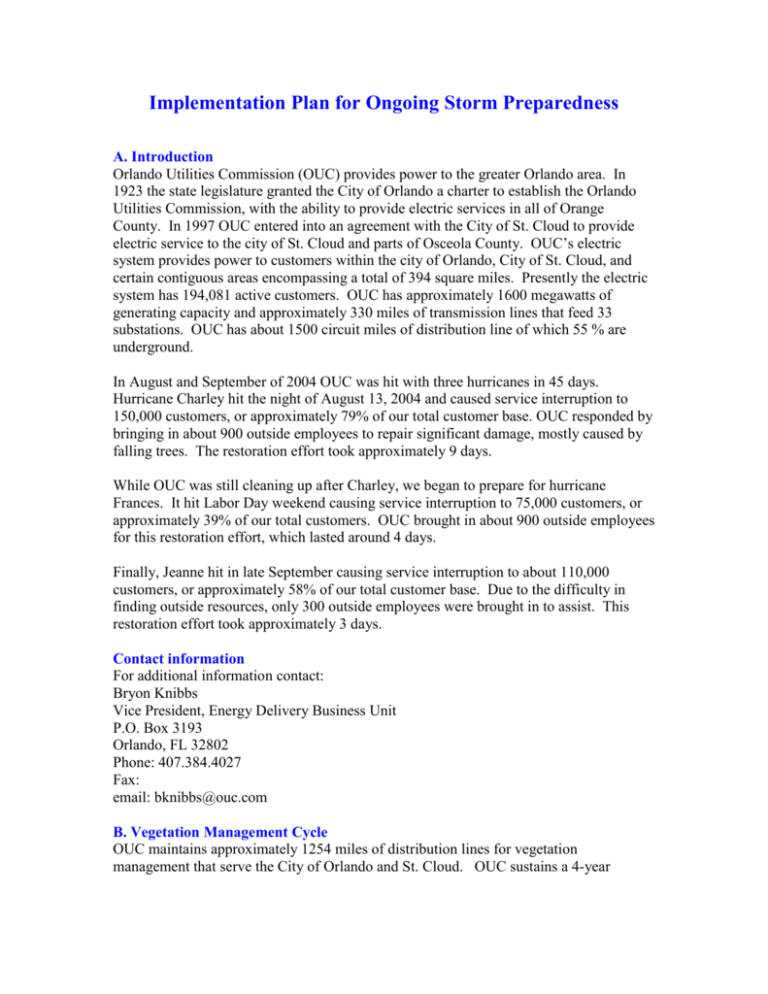
Implementation Plan for Ongoing Storm Preparedness A. Introduction Orlando Utilities Commission (OUC) provides power to the greater Orlando area. In 1923 the state legislature granted the City of Orlando a charter to establish the Orlando Utilities Commission, with the ability to provide electric services in all of Orange County. In 1997 OUC entered into an agreement with the City of St. Cloud to provide electric service to the city of St. Cloud and parts of Osceola County. OUC’s electric system provides power to customers within the city of Orlando, City of St. Cloud, and certain contiguous areas encompassing a total of 394 square miles. Presently the electric system has 194,081 active customers. OUC has approximately 1600 megawatts of generating capacity and approximately 330 miles of transmission lines that feed 33 substations. OUC has about 1500 circuit miles of distribution line of which 55 % are underground. In August and September of 2004 OUC was hit with three hurricanes in 45 days. Hurricane Charley hit the night of August 13, 2004 and caused service interruption to 150,000 customers, or approximately 79% of our total customer base. OUC responded by bringing in about 900 outside employees to repair significant damage, mostly caused by falling trees. The restoration effort took approximately 9 days. While OUC was still cleaning up after Charley, we began to prepare for hurricane Frances. It hit Labor Day weekend causing service interruption to 75,000 customers, or approximately 39% of our total customers. OUC brought in about 900 outside employees for this restoration effort, which lasted around 4 days. Finally, Jeanne hit in late September causing service interruption to about 110,000 customers, or approximately 58% of our total customer base. Due to the difficulty in finding outside resources, only 300 outside employees were brought in to assist. This restoration effort took approximately 3 days. Contact information For additional information contact: Bryon Knibbs Vice President, Energy Delivery Business Unit P.O. Box 3193 Orlando, FL 32802 Phone: 407.384.4027 Fax: email: bknibbs@ouc.com B. Vegetation Management Cycle OUC maintains approximately 1254 miles of distribution lines for vegetation management that serve the City of Orlando and St. Cloud. OUC sustains a 4-year trimming cycle, which is complemented by spot line clearance driven by annual visual feeder inspections. OUC’s trimming schedule is subdivided and closely monitored into annual quarterly goals of 12 feeder circuits, totaling approximately 78 line miles. Further detail to define portions of rear lot and street trimming using GIS information are also being utilized. An average of 25 miles rear lot and 53 street miles per quarter is trimmed. Tracking and completion of schedule progress has been enhanced through the use of GIS mapping. A reliability centered maintenance review is also conducted on a quarterly basis from operational circuit feeder activity. Upon recognition of a suspect feeder, preventive maintenance inspectors conduct a visual review of the circuit for possible clearance issues and corrective action. C. Transmission and Distribution Geographic Information System OUC’s Geographic Information System (GIS) is a multi-faceted system that utilizes GIS, CAD, GPS, and digital video technology. OUC primarily employs ESRI’s ArcGIS 9.1 suite of software with Oracle as the relational database. The system is supplemented using Miner & Miner’s ArcFM and “ArcFM Viewer for ArcEngine” in order to maintain the GIS electric geometric network and to provide map information in the field, respectively. OUC’s transmission and distribution systems, both overhead and underground, are maintained in ArcMap and ArcSDE (Spatial Data Engine). Attributes such as structure number, asset number, operational ID, circuit number, size, material, and phase are stored in the SDE feature attribute tables. Land base data (parcels, roads, water bodies, etc.) are updated monthly from the two counties that OUC partially serves: Orange and Osceola. The counties developed their data layers from survey control points, plats, legal descriptions, and aerial ortho-photography, thereby providing an accurate base for OUC’s GIS. OUC staff and contractors collect coordinates for point-based assets using submeter accurate GPS. Facility locations currently being captured with GPS include transmission poles, cathodic test points, distribution poles, manholes, pad mounted transformers, and other underground distribution equipment. While the overall transmission and distribution system is housed in the GIS database, manhole details and transmission plan & profile drawings are maintained using AutoCAD software. AutoCAD also is employed to design the distribution system. OUC is in the process of capturing digital video of manholes in critical areas such as downtown Orlando and the Orlando International Airport in order to quality assure the accuracy of the maps. All videos are placed on a network server for access by OUC staff. Manhole and engineer design drawings are hyperlinked to the GIS for rapid access. OUC’s central GIS database is exported to the laptop field units three times a week in order to provide up-to-date information to the crews. This data is accessed using ArcReader and ArcFM Viewer. Besides mapping, analysis, and reporting, the GIS is also utilized to feed data to OUC’s outage management system and electric system analysis model. OUC has a number of plans to enhance its GIS and to offer additional tools to staff in the future. These include providing greater integration with other relational databases, such as OUC’s asset management system, Web-based mapping and reporting, and wireless data updates and access. D. Wooden Transmission vs. Concrete Transmission Structures OUC’s transmission system contains wood, steel, concrete, and hybrid structures. All new construction is done with steel poles designed to NESC extreme standards. Any replacement of an existing wood structure is done with steel poles. E. Post-storm Data Gathering, Data Retention and Forensic Analysis OUC’s most recent experience with major storms came in the massive efforts to repair and restore the electric system during Hurricane’s Charley, Francis, and Jeanne. During these storms, the major damage done to OUC electric facilities was a result of trees falling on poles and wires and in some cases uprooting underground facilities. In areas where trees were not present, the overhead electric system faired very well. The main contributors to outages during a major storm are: direct lightning strike, wind blowing conductors together, tree or limb falling on line or pole, flying debris, wind causing pole to fall or snap, and flooding. These are tracked by OUC in our Outage Management System (OMS). OUC will also measure the total impact and severity of the storm by the major pieces of equipment that are replaced (poles, cross-arms, transformers, insulators, miles of conductor) and also minor repairs such as fusing, splicing, etc. OUC will track the amount of labor utilized, as well as the total number of customers out of service and the total duration of the customer’s outage. After a storm, meetings are conducted with staff in order to assess the effectiveness of the storm response plan. After the hurricane season of 2004, a team was formed to rewrite the entire hurricane preparedness plan. This plan defined new procedures based on the lessons learned during the last hurricanes. This plan is now reviewed annually, and updated with any lessons learned from the past season. Due to the importance of having an effective plan, a new vice president was recently appointed with one of her key responsibilities being disaster recovery and keeping the plan up to date. F. Audit of Joint-Use-Attachment Agreements OUC engineers visually inspect and approve every proposed joint-use pole attachment location prior to installation. The joint user has to meet the latest NESC codes related to vertical clearances. A maximum of four joint use attachments are allowed on OUC poles. OUC’s primary distribution poles are designed to a sufficient size and strength to maintain pole integrity from forces associated with joint use attachments (maximum of four) and wind loading per NESC Rule 250B and 250C. If the engineer determines that the addition of another joint use attachment will overload the pole, the entity requesting the joint use must pay to upgrade the pole to a sufficient size. Any analysis performed should consider the overall customer impact of the storm, the level of resources available at the time, the degree of equipment damage, climatic conditions during the restoration period, and the time to achieve the full system restoration. G. Six-year transmission Inspection Program OUC has an outside vendor perform ground-line inspections of each wood transmission pole on a 6-year schedule. Annual inspections of transmission lines, and their corridors, are performed by ground patrols and aerial helicopter. H. Collection of Outage Data Differentiating Between the Reliability Performance of Overhead and Underground Systems OUC currently tracks outage data in our Outage Management System with predefined cause codes assigned to each outage. These cause codes give the dispatchers the ability to differentiate between overhead and underground outages on our system. While reliability indices are not calculated for overhead vs. underground, the data is available for calculation. Also, OUC is currently in the process of defining additional cause codes to enable the gathering of more detailed information on the different types of outages on our system. I. Coordination with Local Governments OUC has a good working relationship with Orange and Osceola County, the City of Orlando and the City of St. Cloud. We are not required to obtain permits to manage the vegetation issues in our service area. Also, OUC is actively involved in governmental Emergency Operations Centers (EOC) during a storm. Having a representative at the EOC during events allows for close communication between the cities/counties and OUC. During the hurricanes of 2004 OUC provided a technician to ride with a city traffic person to expedite returning the traffic lights to normal. This is now part of OUC’s hurricane plan. This year it is part of OUC’s plans to provide a map of where outages are occurring to the City of Orlando. The City plans to use this to help them with ice and water distribution. In preparation for hurricane season the cities and OUC are conducting hurricane preparedness meetings for the public. We performed 15 of these meetings last year and plan to host 10 meetings this season. J. Collaborative Research Through the Public Utility Research Center (PURC) at the University of Florida Through OUC’s membership in the Florida Municipal Electric Association and its interaction with PURC, OUC is involved in PURC activities.
